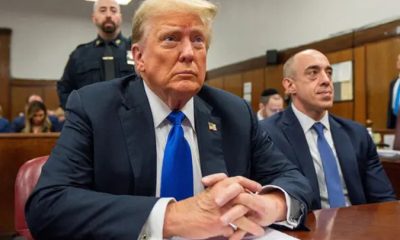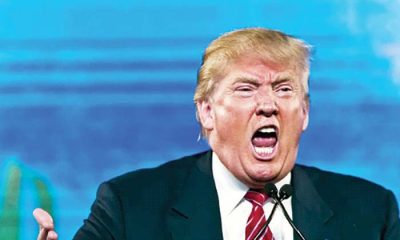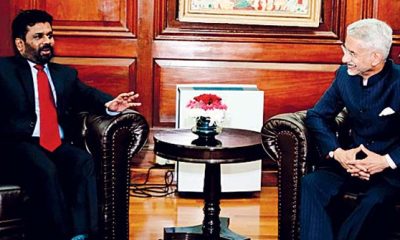Features
US mired in Trump, Chinese puzzle in Africa, India over the moon, Sri Lanka so-so

by Rajan Philips
The fading and the emerging superpowers have had an eventful time this week. Trump’s twisted saga took another massive twist on Thursday with his indictment and surrender at an Atlanta jail in Georgia. He was released on bail after posting a $200,000 bond through a private bonding company. This is Trump’s fourth indictment in five months and by far the largest and the most damning. The unfolding Trump saga involves the intersection of law and politics in the US, showing the former at its best and the latter at its worst. The week also saw the convening of the BRICS summit in South Africa, an underwhelming economic bloc that is also the only formal counter to America’s faltering global hegemony.
Russia’s Putin was a no show. China’s Xi Jinping seemed set to steal the BRICS thunder with the South African government rolling out more than the red carpet to welcome Xi’s arrival in Pretoria on Monday night. Then on Tuesday Xi was a no show for a scheduled speech to a multi-lateral business forum. The unexpected no show led to swirling rumours about the health of the Chinese leader, and even the state media in Beijing seemed to have been caught off guard as it published reports as though Xi had delivered his set speech at the business forum.
The glittering welcome given to Xi on Monday was widely seen as a clear indication of China’s growing influence in Africa. It also had the effect of overshadowing the presence of Modi and the influence of India both at the summit and in the continent. But everything changed when at 6:03 PM local time, Wednesday, India’s lunar spacecraft Chandrayaan-3 executed a perfect soft landing on the south side of the moon. India was literally over the moon.
“This success belongs to all of humanity,” exulted Modi from South Africa. Quite a world apart from the South Africa that Mohandas Gandhi experienced in 1893. Hopefully, someone will remind Modi when he returns to Delhi that his humanity, like that of Mahatma Gandhi, should also include the Muslims of India. In New Delhi, Rahul Gandhi justifiably recalled the beginning of India’s space programme in 1962, and the tremendous strides that have been made since. Although Mr. Gandhi did not drop any name, India’s Prime Minister in 1962 was Jawaharlal Nehru, Rahul Gandhi’s great grandfather and Narendra Modi’s existential bête noire.
There is nothing to exaggerate about the scientific, technological, and most of all cost-efficient achievement that the success of Chandrayaan 3 represents, especially after the failure of its predecessor Chandrayaan 2 in 2019, and the crash landing failure last week of Russia’s Lunar 25. That was Russia’s first mission to the Moon after 1976, and it was also aiming to land near the south pole of the moon. India is now the fourth country to execute a controlled soft landing on the moon, and it joins the elite lunar club alongside the US, Russia and China. It is also the first country to land near the south pole, bringing that region of the moon for the first time into scientific observatories.
Space Business
The space race of the 1960s was monopolized by the US and the then Soviet Union (USSR), as they took to outer space their ideological fight over controlling the planet. There is now talk of a different race driven by market forces and profit motives. Space is already big business with global revenues expected to rise to trillions of dollars (from less than half a trillion now) by mid-21st century. A major driving force is the reduction in launching and, now after Chandrayaan 3, landing costs. In addition to navigation and weather satellites, new enterprises will include manufacturing and mining of the moon and asteroids.
Under Modi’s direction, India is privatizing space launches and inviting foreign investment. The success of Chandrayaan 3 will surely be exploited to achieve the fivefold increase that the Modi government is targeting for foreign investment in the space industry. India is now more than a step ahead in the race for space capital after Russia’s failure this year (not to mention Putin’s war), as well as the 2019 failure of a privately funded moon landing initiative from Israel, and Japan’s failure earlier this year.
From an overall economic standpoint, out of the five BRICS countries (Brazil, Russia, China, India and South Africa) India alone is being seen as the standout country with the “strongest macroeconomic promise” and the least social and political uncertainties. Chandrayaan 3 is a sure fillip to that promise and the prospect to emerge “as the world’s great economic power and foreign investment destination.” India’s broad economic promises are as much due to good political leadership, as they are in spite of bad political lapses.
The Modi government has generated both in equal measure, but the great resilience of India’s democracy is that it can survive a change in government and march on, as it did in 2004 (when a Congress alliance ousted the incumbent BJP government), and again in 2014 (when the BJP led by Narendra Modi turned the tables on the old Congress). It can happen again in 2024, and the country will be richer for it.
A concerning social dimension to the success of Chandrayaan 3 is India’s challenge of prioritizing between providing social protection for the poor and securing capital investment for luxury growth and space programmes. At a global level, prioritization is also about investments in outer space sucking out much needed resources for dealing with problems at home on the planet. Especially climate change problems, and the recurring cycles of forest fires, heavy rains and prolonged droughts.
India’s challenge is all the more critical given the widening disparities in income levels and consumption patterns in the country. A recent Oxfam study suggests that India’s top 1% own 40% of its wealth. The figures are being disputed, but the underlying disparities cannot be denied. Apart from income, less than 30% of working age (15-59 years) women are employed, in contrast to the employment rate of 80% among men. Unemployment is high in the cities, while rural workers on government employment programmes do not receive their wages on time.
So-so Sri Lanka
Things are so-so in Sri Lanka, which is small enough to be beautiful, even if it has to navigate between the fading far away power of America and the far more proximate and emerging powers of India and China. After the tumults of 2022 and a full year of the Wickremesinghe caretaker presidency, there is an appearance of calm over underlying uneasiness. There are no breakthrough signs yet, unless you want to take President Wickremesinghe’s advice to school children to learn Hindi and Chinese, along with English, “in order to fit into the changing world,” as a sign of things to come under an extended Wickremesinghe presidency. This is old colonial thinking applied to new languages.
Will it be a brave new world, where Sinhalese and Tamil children in Sri Lanka can speak to one another in Hindi or Chinese before they go out to conquer the world?. Will it be a better world than the one where Sinhalese children may learn some reasonable Tamil, and Tamil children a bit of official Sinhalese. Already, Tamil children growing up in Europe speaking French or German are apparently not able to talk with their cousins stuck in post-Brexit English.
But the really changing linguistic Sri Lankan landscape belongs to trilingual-fluent Muslims and hill country Tamils, who are also changing the island’s ethno- demographics. It is time anyway, as hill country Tamils mark the 200th anniversary of the arrival of their forefathers from South India to labour on British colonial plantations. It has been a long journey for them.
There are also signs of constitutional lightness of being with parliamentarians led by the Sports Minister getting busy to adopt a new Constitution for “Sri Lanka Cricket” (SLC). That would give some much needed rest to the national constitution, which has been propositioned for change by too many people, too many times, with no outcome to write home about. Things may change if President Wickremesinghe were to decide that it is time for Sri Lankan voters to have an early election and formally (and finally) elect him as their default President.
The economy is humming along, but not at all at the pace to start paying back our debts, or to be on the launchpad for the promised landing in 2048. Tourism and worker remittances have reportedly picked up and brought much needed foreign exchange. And so have agricultural exports. But the apparel sector is apparently in distress as it continues to lose market share to other competitor countries, which seem to be focused on improving technical education and productivity rather than thinking about learning Hindi or Chinese.
According to the World Bank’s country mission, Sri Lanka is still far short of its full potential as an investment destination. Although that should not be the only or even the primary consideration for planning economic growth, the mission’s assessment that Sri Lanka may have missed about USD 10 billion in foreign investment and a corresponding 142,500 jobs, is a metric that Sri Lanka’s aspiring political leaders may want take note of. President Wickremesinghe of course knows it all, but everyone is waiting for him to show it all in results.
Features
The heart-friendly health minister

by Dr Gotabhya Ranasinghe
Senior Consultant Cardiologist
National Hospital Sri Lanka
When we sought a meeting with Hon Dr. Ramesh Pathirana, Minister of Health, he graciously cleared his busy schedule to accommodate us. Renowned for his attentive listening and deep understanding, Minister Pathirana is dedicated to advancing the health sector. His openness and transparency exemplify the qualities of an exemplary politician and minister.
Dr. Palitha Mahipala, the current Health Secretary, demonstrates both commendable enthusiasm and unwavering support. This combination of attributes makes him a highly compatible colleague for the esteemed Minister of Health.
Our discussion centered on a project that has been in the works for the past 30 years, one that no other minister had managed to advance.
Minister Pathirana, however, recognized the project’s significance and its potential to revolutionize care for heart patients.
The project involves the construction of a state-of-the-art facility at the premises of the National Hospital Colombo. The project’s location within the premises of the National Hospital underscores its importance and relevance to the healthcare infrastructure of the nation.
This facility will include a cardiology building and a tertiary care center, equipped with the latest technology to handle and treat all types of heart-related conditions and surgeries.
Securing funding was a major milestone for this initiative. Minister Pathirana successfully obtained approval for a $40 billion loan from the Asian Development Bank. With the funding in place, the foundation stone is scheduled to be laid in September this year, and construction will begin in January 2025.
This project guarantees a consistent and uninterrupted supply of stents and related medications for heart patients. As a result, patients will have timely access to essential medical supplies during their treatment and recovery. By securing these critical resources, the project aims to enhance patient outcomes, minimize treatment delays, and maintain the highest standards of cardiac care.
Upon its fruition, this monumental building will serve as a beacon of hope and healing, symbolizing the unwavering dedication to improving patient outcomes and fostering a healthier society.We anticipate a future marked by significant progress and positive outcomes in Sri Lanka’s cardiovascular treatment landscape within the foreseeable timeframe.
Features
A LOVING TRIBUTE TO JESUIT FR. ALOYSIUS PIERIS ON HIS 90th BIRTHDAY

by Fr. Emmanuel Fernando, OMI
Jesuit Fr. Aloysius Pieris (affectionately called Fr. Aloy) celebrated his 90th birthday on April 9, 2024 and I, as the editor of our Oblate Journal, THE MISSIONARY OBLATE had gone to press by that time. Immediately I decided to publish an article, appreciating the untiring selfless services he continues to offer for inter-Faith dialogue, the renewal of the Catholic Church, his concern for the poor and the suffering Sri Lankan masses and to me, the present writer.
It was in 1988, when I was appointed Director of the Oblate Scholastics at Ampitiya by the then Oblate Provincial Fr. Anselm Silva, that I came to know Fr. Aloy more closely. Knowing well his expertise in matters spiritual, theological, Indological and pastoral, and with the collaborative spirit of my companion-formators, our Oblate Scholastics were sent to Tulana, the Research and Encounter Centre, Kelaniya, of which he is the Founder-Director, for ‘exposure-programmes’ on matters spiritual, biblical, theological and pastoral. Some of these dimensions according to my view and that of my companion-formators, were not available at the National Seminary, Ampitiya.
Ever since that time, our Oblate formators/ accompaniers at the Oblate Scholasticate, Ampitiya , have continued to send our Oblate Scholastics to Tulana Centre for deepening their insights and convictions regarding matters needed to serve the people in today’s context. Fr. Aloy also had tried very enthusiastically with the Oblate team headed by Frs. Oswald Firth and Clement Waidyasekara to begin a Theologate, directed by the Religious Congregations in Sri Lanka, for the contextual formation/ accompaniment of their members. It should very well be a desired goal of the Leaders / Provincials of the Religious Congregations.
Besides being a formator/accompanier at the Oblate Scholasticate, I was entrusted also with the task of editing and publishing our Oblate journal, ‘The Missionary Oblate’. To maintain the quality of the journal I continue to depend on Fr. Aloy for his thought-provoking and stimulating articles on Biblical Spirituality, Biblical Theology and Ecclesiology. I am very grateful to him for his generous assistance. Of late, his writings on renewal of the Church, initiated by Pope St. John XX111 and continued by Pope Francis through the Synodal path, published in our Oblate journal, enable our readers to focus their attention also on the needed renewal in the Catholic Church in Sri Lanka. Fr. Aloy appreciated very much the Synodal path adopted by the Jesuit Pope Francis for the renewal of the Church, rooted very much on prayerful discernment. In my Religious and presbyteral life, Fr.Aloy continues to be my spiritual animator / guide and ongoing formator / acccompanier.
Fr. Aloysius Pieris, BA Hons (Lond), LPh (SHC, India), STL (PFT, Naples), PhD (SLU/VC), ThD (Tilburg), D.Ltt (KU), has been one of the eminent Asian theologians well recognized internationally and one who has lectured and held visiting chairs in many universities both in the West and in the East. Many members of Religious Congregations from Asian countries have benefited from his lectures and guidance in the East Asian Pastoral Institute (EAPI) in Manila, Philippines. He had been a Theologian consulted by the Federation of Asian Bishops’ Conferences for many years. During his professorship at the Gregorian University in Rome, he was called to be a member of a special group of advisers on other religions consulted by Pope Paul VI.
Fr. Aloy is the author of more than 30 books and well over 500 Research Papers. Some of his books and articles have been translated and published in several countries. Among those books, one can find the following: 1) The Genesis of an Asian Theology of Liberation (An Autobiographical Excursus on the Art of Theologising in Asia, 2) An Asian Theology of Liberation, 3) Providential Timeliness of Vatican 11 (a long-overdue halt to a scandalous millennium, 4) Give Vatican 11 a chance, 5) Leadership in the Church, 6) Relishing our faith in working for justice (Themes for study and discussion), 7) A Message meant mainly, not exclusively for Jesuits (Background information necessary for helping Francis renew the Church), 8) Lent in Lanka (Reflections and Resolutions, 9) Love meets wisdom (A Christian Experience of Buddhism, 10) Fire and Water 11) God’s Reign for God’s poor, 12) Our Unhiddden Agenda (How we Jesuits work, pray and form our men). He is also the Editor of two journals, Vagdevi, Journal of Religious Reflection and Dialogue, New Series.
Fr. Aloy has a BA in Pali and Sanskrit from the University of London and a Ph.D in Buddhist Philosophy from the University of Sri Lankan, Vidyodaya Campus. On Nov. 23, 2019, he was awarded the prestigious honorary Doctorate of Literature (D.Litt) by the Chancellor of the University of Kelaniya, the Most Venerable Welamitiyawe Dharmakirthi Sri Kusala Dhamma Thera.
Fr. Aloy continues to be a promoter of Gospel values and virtues. Justice as a constitutive dimension of love and social concern for the downtrodden masses are very much noted in his life and work. He had very much appreciated the commitment of the late Fr. Joseph (Joe) Fernando, the National Director of the Social and Economic Centre (SEDEC) for the poor.
In Sri Lanka, a few religious Congregations – the Good Shepherd Sisters, the Christian Brothers, the Marist Brothers and the Oblates – have invited him to animate their members especially during their Provincial Congresses, Chapters and International Conferences. The mainline Christian Churches also have sought his advice and followed his seminars. I, for one, regret very much, that the Sri Lankan authorities of the Catholic Church –today’s Hierarchy—- have not sought Fr.
Aloy’s expertise for the renewal of the Catholic Church in Sri Lanka and thus have not benefited from the immense store of wisdom and insight that he can offer to our local Church while the Sri Lankan bishops who governed the Catholic church in the immediate aftermath of the Second Vatican Council (Edmund Fernando OMI, Anthony de Saram, Leo Nanayakkara OSB, Frank Marcus Fernando, Paul Perera,) visited him and consulted him on many matters. Among the Tamil Bishops, Bishop Rayappu Joseph was keeping close contact with him and Bishop J. Deogupillai hosted him and his team visiting him after the horrible Black July massacre of Tamils.
Features
A fairy tale, success or debacle

Sri Lanka-Singapore Free Trade Agreement
By Gomi Senadhira
senadhiragomi@gmail.com
“You might tell fairy tales, but the progress of a country cannot be achieved through such narratives. A country cannot be developed by making false promises. The country moved backward because of the electoral promises made by political parties throughout time. We have witnessed that the ultimate result of this is the country becoming bankrupt. Unfortunately, many segments of the population have not come to realize this yet.” – President Ranil Wickremesinghe, 2024 Budget speech
Any Sri Lankan would agree with the above words of President Wickremesinghe on the false promises our politicians and officials make and the fairy tales they narrate which bankrupted this country. So, to understand this, let’s look at one such fairy tale with lots of false promises; Ranil Wickremesinghe’s greatest achievement in the area of international trade and investment promotion during the Yahapalana period, Sri Lanka-Singapore Free Trade Agreement (SLSFTA).
It is appropriate and timely to do it now as Finance Minister Wickremesinghe has just presented to parliament a bill on the National Policy on Economic Transformation which includes the establishment of an Office for International Trade and the Sri Lanka Institute of Economics and International Trade.
Was SLSFTA a “Cleverly negotiated Free Trade Agreement” as stated by the (former) Minister of Development Strategies and International Trade Malik Samarawickrama during the Parliamentary Debate on the SLSFTA in July 2018, or a colossal blunder covered up with lies, false promises, and fairy tales? After SLSFTA was signed there were a number of fairy tales published on this agreement by the Ministry of Development Strategies and International, Institute of Policy Studies, and others.
However, for this article, I would like to limit my comments to the speech by Minister Samarawickrama during the Parliamentary Debate, and the two most important areas in the agreement which were covered up with lies, fairy tales, and false promises, namely: revenue loss for Sri Lanka and Investment from Singapore. On the other important area, “Waste products dumping” I do not want to comment here as I have written extensively on the issue.
1. The revenue loss
During the Parliamentary Debate in July 2018, Minister Samarawickrama stated “…. let me reiterate that this FTA with Singapore has been very cleverly negotiated by us…. The liberalisation programme under this FTA has been carefully designed to have the least impact on domestic industry and revenue collection. We have included all revenue sensitive items in the negative list of items which will not be subject to removal of tariff. Therefore, 97.8% revenue from Customs duty is protected. Our tariff liberalisation will take place over a period of 12-15 years! In fact, the revenue earned through tariffs on goods imported from Singapore last year was Rs. 35 billion.
The revenue loss for over the next 15 years due to the FTA is only Rs. 733 million– which when annualised, on average, is just Rs. 51 million. That is just 0.14% per year! So anyone who claims the Singapore FTA causes revenue loss to the Government cannot do basic arithmetic! Mr. Speaker, in conclusion, I call on my fellow members of this House – don’t mislead the public with baseless criticism that is not grounded in facts. Don’t look at petty politics and use these issues for your own political survival.”
I was surprised to read the minister’s speech because an article published in January 2018 in “The Straits Times“, based on information released by the Singaporean Negotiators stated, “…. With the FTA, tariff savings for Singapore exports are estimated to hit $10 million annually“.
As the annual tariff savings (that is the revenue loss for Sri Lanka) calculated by the Singaporean Negotiators, Singaporean $ 10 million (Sri Lankan rupees 1,200 million in 2018) was way above the rupees’ 733 million revenue loss for 15 years estimated by the Sri Lankan negotiators, it was clear to any observer that one of the parties to the agreement had not done the basic arithmetic!
Six years later, according to a report published by “The Morning” newspaper, speaking at the Committee on Public Finance (COPF) on 7th May 2024, Mr Samarawickrama’s chief trade negotiator K.J. Weerasinghehad had admitted “…. that forecasted revenue loss for the Government of Sri Lanka through the Singapore FTA is Rs. 450 million in 2023 and Rs. 1.3 billion in 2024.”
If these numbers are correct, as tariff liberalisation under the SLSFTA has just started, we will pass Rs 2 billion very soon. Then, the question is how Sri Lanka’s trade negotiators made such a colossal blunder. Didn’t they do their basic arithmetic? If they didn’t know how to do basic arithmetic they should have at least done their basic readings. For example, the headline of the article published in The Straits Times in January 2018 was “Singapore, Sri Lanka sign FTA, annual savings of $10m expected”.
Anyway, as Sri Lanka’s chief negotiator reiterated at the COPF meeting that “…. since 99% of the tariffs in Singapore have zero rates of duty, Sri Lanka has agreed on 80% tariff liberalisation over a period of 15 years while expecting Singapore investments to address the imbalance in trade,” let’s turn towards investment.
Investment from Singapore
In July 2018, speaking during the Parliamentary Debate on the FTA this is what Minister Malik Samarawickrama stated on investment from Singapore, “Already, thanks to this FTA, in just the past two-and-a-half months since the agreement came into effect we have received a proposal from Singapore for investment amounting to $ 14.8 billion in an oil refinery for export of petroleum products. In addition, we have proposals for a steel manufacturing plant for exports ($ 1 billion investment), flour milling plant ($ 50 million), sugar refinery ($ 200 million). This adds up to more than $ 16.05 billion in the pipeline on these projects alone.
And all of these projects will create thousands of more jobs for our people. In principle approval has already been granted by the BOI and the investors are awaiting the release of land the environmental approvals to commence the project.
I request the Opposition and those with vested interests to change their narrow-minded thinking and join us to develop our country. We must always look at what is best for the whole community, not just the few who may oppose. We owe it to our people to courageously take decisions that will change their lives for the better.”
According to the media report I quoted earlier, speaking at the Committee on Public Finance (COPF) Chief Negotiator Weerasinghe has admitted that Sri Lanka was not happy with overall Singapore investments that have come in the past few years in return for the trade liberalisation under the Singapore-Sri Lanka Free Trade Agreement. He has added that between 2021 and 2023 the total investment from Singapore had been around $162 million!
What happened to those projects worth $16 billion negotiated, thanks to the SLSFTA, in just the two-and-a-half months after the agreement came into effect and approved by the BOI? I do not know about the steel manufacturing plant for exports ($ 1 billion investment), flour milling plant ($ 50 million) and sugar refinery ($ 200 million).
However, story of the multibillion-dollar investment in the Petroleum Refinery unfolded in a manner that would qualify it as the best fairy tale with false promises presented by our politicians and the officials, prior to 2019 elections.
Though many Sri Lankans got to know, through the media which repeatedly highlighted a plethora of issues surrounding the project and the questionable credentials of the Singaporean investor, the construction work on the Mirrijiwela Oil Refinery along with the cement factory began on the24th of March 2019 with a bang and Minister Ranil Wickremesinghe and his ministers along with the foreign and local dignitaries laid the foundation stones.
That was few months before the 2019 Presidential elections. Inaugurating the construction work Prime Minister Ranil Wickremesinghe said the projects will create thousands of job opportunities in the area and surrounding districts.
The oil refinery, which was to be built over 200 acres of land, with the capacity to refine 200,000 barrels of crude oil per day, was to generate US$7 billion of exports and create 1,500 direct and 3,000 indirect jobs. The construction of the refinery was to be completed in 44 months. Four years later, in August 2023 the Cabinet of Ministers approved the proposal presented by President Ranil Wickremesinghe to cancel the agreement with the investors of the refinery as the project has not been implemented! Can they explain to the country how much money was wasted to produce that fairy tale?
It is obvious that the President, ministers, and officials had made huge blunders and had deliberately misled the public and the parliament on the revenue loss and potential investment from SLSFTA with fairy tales and false promises.
As the president himself said, a country cannot be developed by making false promises or with fairy tales and these false promises and fairy tales had bankrupted the country. “Unfortunately, many segments of the population have not come to realize this yet”.
(The writer, a specialist and an activist on trade and development issues . )
























